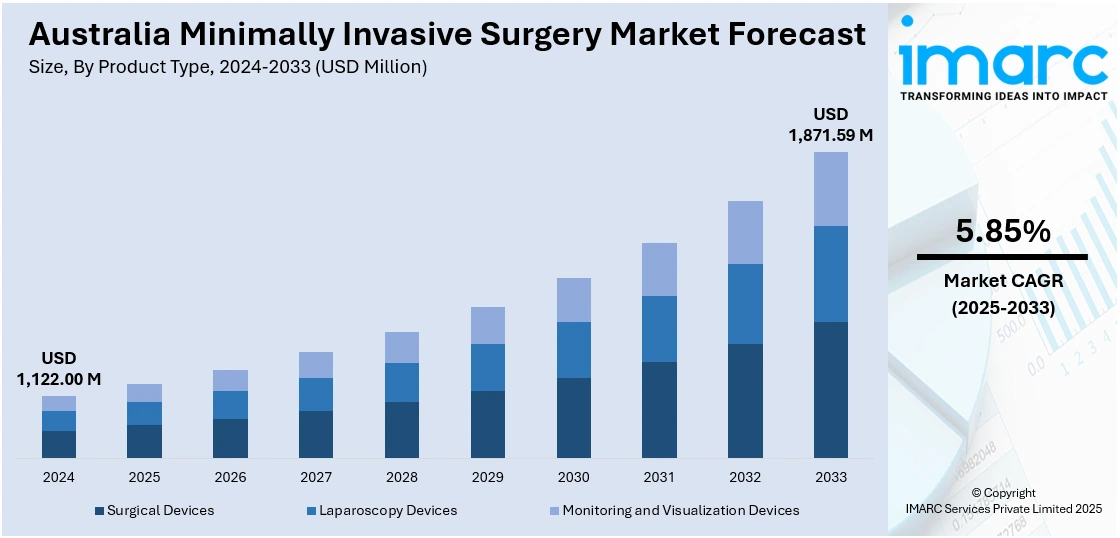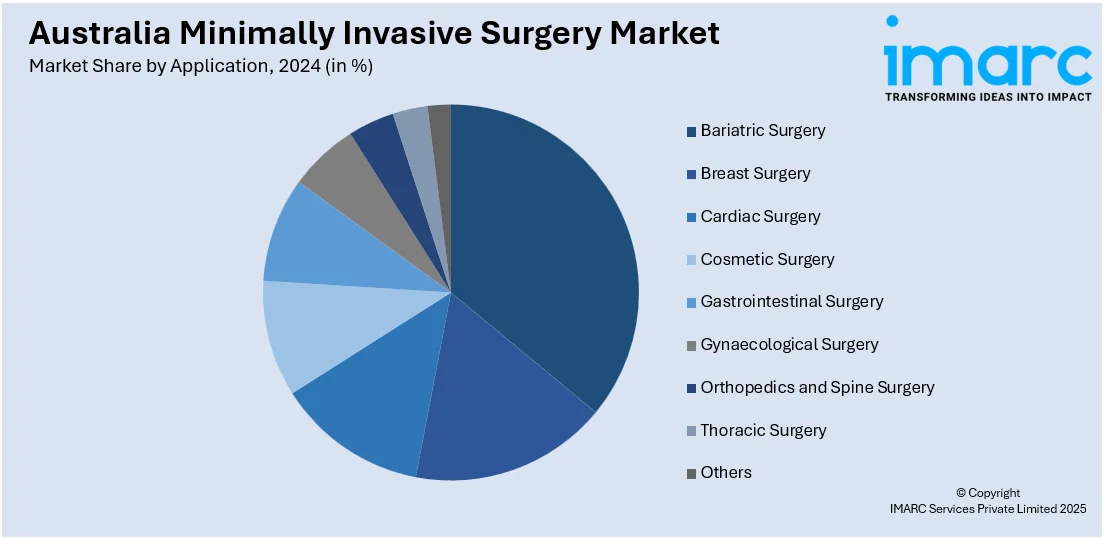
Australia Minimally Invasive Surgery Market Size, Share, Trends and Forecast by Product Type, Application, End-User, and Region, 2025-2033
Australia Minimally Invasive Surgery Market Overview:
The Australia minimally invasive surgery market size reached USD 1,122.00 Million in 2024. Looking forward, IMARC Group expects the market to reach USD 1,871.59 Million by 2033, exhibiting a growth rate (CAGR) of 5.85% during 2025-2033. The market is driven by advances in technology, increasing patient demand for faster recovery, and amplified adoption across specialties, fueling its positive growth trajectory and a move towards more efficient, less invasive surgeries.
|
Report Attribute
|
Key Statistics
|
|---|---|
|
Base Year
|
2024 |
|
Forecast Years
|
2025-2033
|
|
Historical Years
|
2019-2024
|
| Market Size in 2024 | USD 1,122.00 Million |
| Market Forecast in 2033 | USD 1,871.59 Million |
| Market Growth Rate 2025-2033 | 5.85% |
Australia Minimally Invasive Surgery Market Trends:
Increasing Use of Advanced Robotic Systems
The use of advanced robotic technology is one of the top trends fueling the growth of minimally invasive surgery (MIS) in Australia. For instance, in February 2024, Philips' LumiGuide, launched Fiber Optic RealShape (FORS) technology to enable radiation-free, 3D-guided minimally invasive surgery. This innovation, now expanding in aortic centers, promises faster, safer procedures and reduced radiation exposure in Australia and globally. Moreover, robotic-assisted surgical procedures provide improved accuracy, dexterity, and control within surgeries, which shorten the patient's recovery time considerably. Using robotic technology enables surgeons to conduct intricate procedures with minimal cuts, resulting in less tissue destruction and fewer risks of complications. Consequently, the need for robotic systems in Australian clinics and hospitals has been steadily on the rise, mirroring the increasing demand for less invasive procedures. Australia minimally invasive surgery market outlook is positive, as the use of robotic technologies continues to enhance surgical results and patient satisfaction. The trend also supports overall healthcare efforts in Australia, which focus on enhanced patient experiences and operational efficiency. The ongoing innovation and growth in robotic systems are likely to make significant contributions to the future development of Australia's minimally invasive surgery share.

To get more information on this market, Request Sample
Growing Applications across Other Medical Specialties
Minimally invasive surgery is broadening its applications in diverse medical specialties further driving the development of the Australian market. For example, in March 2025, Spinal Simplicity released regulatory approval for its Minuteman® G5 interspinous fusion device in Australia and New Zealand. This minimally invasive solution provides shorter recovery times and enhanced patient outcomes for spinal conditions. Furthermore, while traditionally utilized primarily in specialties such as orthopedics and urology, minimally invasive approaches are now increasingly being adopted in other specialized fields, including gastrointestinal, cardiac, and gynecological surgeries. This expansion of use is fueled by accelerating widespread recognition of the advantages of minimally invasive methods, including decreased hospital stays, quicker recovery periods, and fewer complications. Since both patients and medical professionals intensely are looking for alternatives to conventional open surgery, movement towards these methods is increasingly gaining force. The growing number of procedures that can be carried out with minimally invasive methods has created a boom in demand, mounting Australia minimally invasive surgery market share. With improvements in surgical equipment and tools as well as technology further improving with each passing day, this trend will also continue to fuel Australia's minimally invasive surgery market outlook and ensure its continued growth.
Increasing Demand for Outpatient and Same-Day Discharge Procedures
An important trend shaping the Australian minimally invasive surgery market is the increased need for same-day discharge procedures and outpatient procedures. Due to the growing affinity for speedy recovery and shorter hospital stays, most patients these days prefer procedures that enable them to go home on the same day. Minimally invasive surgeries are especially suited for this need because they are less invasive in nature and reduce the necessity of long post-operative care. This trend has been driven by patient desire for comfort as well as by the desire for efficiency and cost savings on the part of the healthcare system. Consequently, hospitals and clinics are implementing minimally invasive methods for a wider variety of surgeries to address these needs. Australia minimally invasive surgery market growth is intricately linked with this change since patients increasingly prefer outpatient procedures, causing the spread and availability as well as access to minimally invasive treatment. This trend has the potential to define the market in the near future.
Australia Minimally Invasive Surgery Market Segmentation:
IMARC Group provides an analysis of the key trends in each segment of the market, along with forecasts at the country and regional levels for 2025-2033. Our report has categorized the market based on product type, application, and end user.
Product Type Insights:
- Surgical Devices
- Laparoscopy Devices
- Monitoring and Visualization Devices
The report has provided a detailed breakup and analysis of the market based on the product type. This includes surgical devices, laparoscopy devices, and monitoring and visualization devices.
Application Insights:

- Bariatric Surgery
- Breast Surgery
- Cardiac Surgery
- Cosmetic Surgery
- Gastrointestinal Surgery
- Gynaecological Surgery
- Orthopedics and Spine Surgery
- Thoracic Surgery
- Others
A detailed breakup and analysis of the market based on the application have also been provided in the report. This includes bariatric surgery, breast surgery, cardiac surgery, cosmetic surgery, gastrointestinal surgery, gynaecological surgery, orthopedics and spine surgery, thoracic surgery, and others.
End User Insights:
- Hospitals
- Clinics
- Others
The report has provided a detailed breakup and analysis of the market based on the end user. This includes hospitals, clinics, and others.
Regional Insights:
- Australia Capital Territory & New South Wales
- Victoria & Tasmania
- Queensland
- Northern Territory & Southern Australia
- Western Australia
The report has also provided a comprehensive analysis of all the major regional markets, which include Australia Capital Territory & New South Wales, Victoria & Tasmania, Queensland, Northern Territory & Southern Australia, and Western Australia.
Competitive Landscape:
The market research report has also provided a comprehensive analysis of the competitive landscape. Competitive analysis such as market structure, key player positioning, top winning strategies, competitive dashboard, and company evaluation quadrant has been covered in the report. Also, detailed profiles of all major companies have been provided.
Australia Minimally Invasive Surgery Market News:
- In July 2024, Brisbane-founded Convergence Medical launched the V01 Arthroscopic Surgical Robot, which improves precision, efficiency, and safety in joint damage repairs. Its goal is FDA clearance by the year 2025, making minimally invasive surgery more powerful.
Australia Minimally Invasive Surgery Market Report Coverage:
| Report Features | Details |
|---|---|
| Base Year of the Analysis | 2024 |
| Historical Period | 2019-2024 |
| Forecast Period | 2025-2033 |
| Units | Million USD |
| Scope of the Report | Exploration of Historical Trends and Market Outlook, Industry Catalysts and Challenges, Segment-Wise Historical and Future Market Assessment:
|
| Product Types Covered | Surgical Devices, Laparoscopy Devices, Monitoring and Visualization Devices |
| Applications Covered | Bariatric Surgery, Breast Surgery, Cardiac Surgery, Cosmetic Surgery, Gastrointestinal Surgery, Gynaecological Surgery, Orthopedics and Spine Surgery, Thoracic Surgery, Others |
| End-Users Covered | Hospitals, Clinics, Others |
| Regions Covered | Australia Capital Territory & New South Wales, Victoria & Tasmania, Queensland, Northern Territory & Southern Australia, Western Australia |
| Customization Scope | 10% Free Customization |
| Post-Sale Analyst Support | 10-12 Weeks |
| Delivery Format | PDF and Excel through Email (We can also provide the editable version of the report in PPT/Word format on special request) |
Key Questions Answered in This Report:
- How has the Australia minimally invasive surgery market performed so far and how will it perform in the coming years?
- What is the breakup of the Australia minimally invasive surgery market on the basis of product type?
- What is the breakup of the Australia minimally invasive surgery market on the basis of application?
- What is the breakup of the Australia minimally invasive surgery market on the basis of end use?
- What is the breakup of the Australia minimally invasive surgery market on the basis of region?
- What are the various stages in the value chain of the Australia minimally invasive surgery market?
- What are the key driving factors and challenges in the Australia minimally invasive surgery?
- What is the structure of the Australia minimally invasive surgery market and who are the key players?
- What is the degree of competition in the Australia minimally invasive surgery market?
Key Benefits for Stakeholders:
- IMARC’s industry report offers a comprehensive quantitative analysis of various market segments, historical and current market trends, market forecasts, and dynamics of the Australia minimally invasive surgery market from 2019-2033.
- The research report provides the latest information on the market drivers, challenges, and opportunities in the Australia minimally invasive surgery market.
- Porter's five forces analysis assist stakeholders in assessing the impact of new entrants, competitive rivalry, supplier power, buyer power, and the threat of substitution. It helps stakeholders to analyze the level of competition within the Australia minimally invasive surgery industry and its attractiveness.
- Competitive landscape allows stakeholders to understand their competitive environment and provides an insight into the current positions of key players in the market.
Need more help?
- Speak to our experienced analysts for insights on the current market scenarios.
- Include additional segments and countries to customize the report as per your requirement.
- Gain an unparalleled competitive advantage in your domain by understanding how to utilize the report and positively impacting your operations and revenue.
- For further assistance, please connect with our analysts.
 Request Customization
Request Customization
 Speak to an Analyst
Speak to an Analyst
 Request Brochure
Request Brochure
 Inquire Before Buying
Inquire Before Buying




.webp)




.webp)












